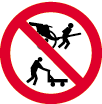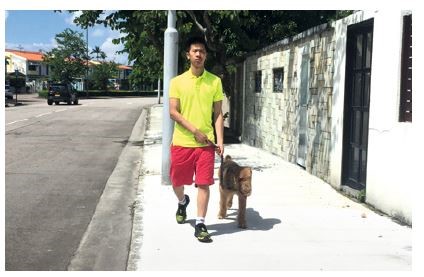 You must not pass a traffic sign banning pedestrians or banning rickshaws and handcarts, or use the road to which the ban applies. You must not enter or use a tunnel area or control area (see the signs on page 73).
You must not pass a traffic sign banning pedestrians or banning rickshaws and handcarts, or use the road to which the ban applies. You must not enter or use a tunnel area or control area (see the signs on page 73).Handcarts, trolleys
If you are using a handcart, trolley or any other pedestrian controlled vehicle, you need to take extra care to protect your safety and the safety of others.
Use the pavement whenever possible, particularly with a small cart, but do not endanger or inconvenience other pedestrians. Follow the rules and advice for pedestrians, particularly when crossing the road.
If you are using a large cart or the pavement is crowded or too narrow, you should use the roadway. Wearing bright, light-coloured, fluorescent or reflecting clothing will help other road users to see you, particularly at night or in poor visibility.
When using the roadway, keep to the left and follow the rules and advice for drivers; it is important for your safety to obey traffic light signals and traffic signs. Do not push or pull your cart or trolley the wrong way along a one-way road or on the right-hand side of a two-way road. Give way to pedestrians at pedestrian crossings. Keep looking behind regularly when moving along the road.
 You must not pass a traffic sign banning pedestrians or banning rickshaws and handcarts, or use the road to which the ban applies. You must not enter or use a tunnel area or control area (see the signs on page 73).
You must not pass a traffic sign banning pedestrians or banning rickshaws and handcarts, or use the road to which the ban applies. You must not enter or use a tunnel area or control area (see the signs on page 73).
You must also not enter or use an expressway. Traffic signs are installed to mark the start and end points of an expressway (see the signs on page 71).
Try not to push your cart along busy roads. Do not use elevated roads, flyovers or underpasses.
Do not leave your cart or trolley unattended on a pavement or roadway or where it may cause obstruction or danger to any person or traffic, for example by forcing pedestrians to step onto the roadway.
Looking after your animals on the road
Do not let your pet or animal out on its own. On the road, you must keep it on a lead or under proper control, and away from the roadway as far as practicable.
When you and your pet are on a pavement or the side of the road (when there is no pavement), walk between them and the traffic.
Riding a horse on roads with traffic should be avoided. However, if you have to ride a horse on the road, make sure you can control it in traffic.
Do not ride recklessly or negligently, or at a speed or in a manner which is dangerous to other road users.
When riding, keep to the left of the road. If you are leading a horse, on foot or while riding another, you should also keep to the left and keep the led animal on your left. On oneway roads, proceed only in the direction of the traffic and keep to the left. If you are riding a horse, you should wear a hard hat and lightcoloured, reflective or fluorescent clothing.

If you are leading or herding animals, keep to the left of the road and look out for traffic particularly at places such as bends and brows of hills where drivers may not be able to see you. If you need to walk with your back to the traffic, keep looking behind you to watch out for traffic and keep listening at all times. Make sure approaching drivers can see you. After sunset, wear light-coloured or reflective clothing and carry lights which show white to the front and red to the rear.
Do not ride, lead or drive a horse or other large animal on a footpath or pavement by the side of the road.
Marching groups and processions
Organisers of marching groups or public processions should make an application to the police well in advance and follow their advice given on using the roads. A group of people marching on the road should keep to the left. There should be look-outs in front and at the back wearing reflective clothing at night and fluorescent clothing by day. At night the look-out in front should carry a white or amber light, and the one at the back a bright red or amber light visible from the rear. Additional lights should be carried and reflective clothing worn by the out-side rank of long columns. It is preferable if all marchers wear reflective and/or fluorescent clothing.